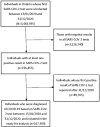Association of pre-existing comorbidities with mortality and disease severity among 167,500 individuals with COVID-19 in Canada: A population-based cohort study
- PMID: 34610047
- PMCID: PMC8491945
- DOI: 10.1371/journal.pone.0258154
Association of pre-existing comorbidities with mortality and disease severity among 167,500 individuals with COVID-19 in Canada: A population-based cohort study
Abstract
Background: The novel coronavirus disease 2019 (COVID-19) has infected 1.9% of the world population by May 2, 2021. Since most previous studies that examined risk factors for mortality and severity were based on hospitalized individuals, population-based cohort studies are called for to provide evidence that can be extrapolated to the general population. Therefore, we aimed to examine the associations of comorbidities with mortality and disease severity in individuals with COVID-19 diagnosed in 2020 in Ontario, Canada.
Methods and findings: We conducted a retrospective cohort study of all individuals with COVID-19 in Ontario, Canada diagnosed between January 15 and December 31, 2020. Cases were linked to health administrative databases maintained in the ICES which covers all residents in Ontario. The primary outcome is all-cause 30-day mortality after the first COVID-19 diagnosis, and the secondary outcome is a composite severity index containing death and hospitalization. To examine the risk factors for the outcomes, we employed Cox proportional hazards regression models and logistic regression models to adjust for demographic, socio-economic variables and comorbidities. Results were also stratified by age groups. A total of 167,500 individuals were diagnosed of COVID-19 in 2020 and included in the study. About half (43.8%, n = 73,378) had at least one comorbidity. The median follow-up period were 30 days. The most common comorbidities were hypertension (24%, n = 40,154), asthma (16%, n = 26,814), and diabetes (14.7%, n = 24,662). Individuals with comorbidity had higher risk of mortality compared to those without (HR = 2.80, 95%CI 2.35-3.34; p<0.001), and the risk substantially was elevated from 2.14 (95%CI 1.76-2.60) to 4.81 (95%CI 3.95-5.85) times as the number of comorbidities increased from one to five or more. Significant predictors for mortality included comorbidities such as solid organ transplant (HR = 3.06, 95%CI 2.03-4.63; p<0.001), dementia (HR = 1.46, 95%CI 1.35-1.58; p<0.001), chronic kidney disease (HR = 1.45, 95%CI 1.34-1.57; p<0.001), severe mental illness (HR = 1.42, 95%CI%, 1.12-1.80; p<0.001), cardiovascular disease (CVD) (HR = 1.22, 95%CI, 1.15-1.30), diabetes (HR = 1.19, 95%, 1.12-1.26; p<0.001), chronic obstructive pulmonary disease (COPD) (HR = 1.19, 95%CI 1.12-1.26; p<0.001), cancer (HR = 1.17, 95%CI, 1.09-1.27; p<0.001), hypertension (HR = 1.16, 95%CI, 1.07-1.26; p<0.001). Compared to their effect in older age groups, comorbidities were associated with higher risk of mortality and severity in individuals under 50 years old. Individuals with five or more comorbidities in the below 50 years age group had 395.44 (95%CI, 57.93-2699.44, p<0.001) times higher risk of mortality compared to those without. Limitations include that data were collected during 2020 when the new variants of concern were not predominant, and that the ICES databases do not contain detailed individual-level socioeconomic and racial variables.
Conclusion: We found that solid organ transplant, dementia, chronic kidney disease, severe mental illness, CVD, hypertension, COPD, cancer, diabetes, rheumatoid arthritis, HIV, and asthma were associated with mortality or severity. Our study highlights that the number of comorbidities was a strong risk factor for deaths and severe outcomes among younger individuals with COVID-19. Our findings suggest that in addition of prioritizing by age, vaccination priority groups should also include younger population with multiple comorbidities.
Conflict of interest statement
The authors have declared that no competing interests exist.
Figures




References
-
- WHO coronavirus (COVID-19) dashboard [https://www.who.int/emergencies/diseases/novel-coronavirus-2019?gclid=Cj...]
-
- Kontis V, Bennett JE, Rashid T, Parks RM, Pearson-Stuttard J, Guillot M, et al.: Magnitude, demographics and dynamics of the effect of the first wave of the COVID-19 pandemic on all-cause mortality in 21 industrialized countries. Nature Medicine 2020, 26(12):1919–1928. doi: 10.1038/s41591-020-1112-0 - DOI - PMC - PubMed
Publication types
MeSH terms
LinkOut - more resources
Full Text Sources
Medical

